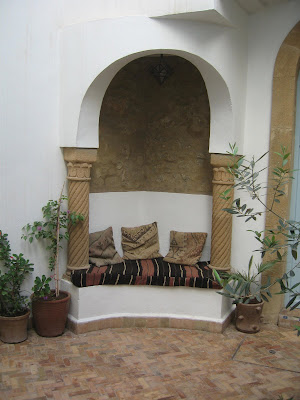 The door to Dar Zette
The door to Dar ZetteAfter the wet and grey summer in England (and Wales, where we spent a fortnight) we were feeling very sun-deprived. We decided to push out the boat and have another break away from home, hoping to boost our vitamin D in preparation for the winter. A new flight route between Bristol and Marrakech made Morocco an easier possibility, and some research turned up a lovely and available villa,
Dar Zette. Essaouira appealed because it is on the coast, it has the reputation for being more laid-back than Marrakech, and without the pushiness and mopeds in the souks, and because my blogging friend
Elizabeth loves it there, and she has wonderful taste.
We actually took the very first flight to Marrakech from Bristol, and there were celebrations: Ryanair had provided Morrocan pastries and hors d'eouvres by the check in desks (sadly with no gluten-free options) and also belly dancers, whose music we heard as we queued for security but regrettably otherwise missed. I'm not sure that we were really expected when we arrived at the other end, as traffic control required us to circle the city some six or so times before we were allowed to land. This was actually quite interesting as I was beginning to find inspiration in the patterns on the dessert and the cultivated areas of land, and was about to request my camera from the overhead locker when we were given clearance and a slot. The first passengers off the plane were filmed for local television so maybe the cameraman was delayed getting to the airport.... The air was pleasantly warm as we stepped out of the plane and onto Moroccan soil.
Anyway, we were there and all went smoothly if slowly. I had wheelchair assistance at the airport and was whizzed through passport control but then was parked for about three quarters of an hour while the rest of the family made their way through the queues at immigration/passport control. Eventually we were reunited and we found our driver for the journey to the coast.
The drive takes about two and a half to three hours, through a slowly changing landscape. The city gives way to the garden centres of the suburbs and then to red-soiled land punctuated by farms, settlements and little towns, trees and earth-built walls, the odd berber tent and goats. Eventually the earth began to turn paler with flecks of white. We stopped for a comfort break in a small town whose name I never discovered, and a bite to eat (most welcome, after breakfast at 4 a.m.), Then on, through roadworks due to an upgrading of the road surface, and pausing at a viewpoint to admire the lovely view over Essaouira and the sea. Essaouira reflected the colours of the locality: most buildings are white with blue paintwork, within the red medina walls. We arrived at Bab Marrakesh, to be met by Foued and fought over by two porters who wished to carry our baggage the short distance to the Dar. Foued sorted out this squabble and we were duly whisked along the street a short distance, to turn off the street into a covered alleyway and at the end stood the door to our home-for-a-week.
Moroccan houses contain secret treasures inside plain trappings, and Dar Zette was no different. The door opened through an arch into the courtyard, a quiet haven despite being only a few yards from one of the Medina's main streets. The white-painted walls, blue fountain, pretty central olive tree and warm terracotta floor tiles created a cool and calm atmosphere. We were welcomed by our maid, Sadir, and through Foued we arranged for her to cook us a tagine for dinner that evening. We were a little alarmed to be told that the water was cut off due to an explosion, but this turned out to be a mistranslation and there had been a burst water main, which cut off the water supply to all the town. We were assured that work was underway to restore the water, and meanwhile we had bottles of drinking water in the fridge.




So now all we had to to was to choose our bedrooms, settle in and make ourselves at home, explore and relax and look forward to eating the delicious tagine of chicken with lemons and olives being prepared for our delight.
Another beautiful pair we stumbled upon in the maze of medina streets.


